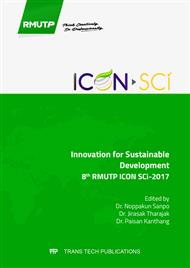[1]
J. Mol, E. Grotewold and R. Koes, How genes paint flowers and seeds, Trends Plant Sci. 3(1998) 212–217.
DOI: 10.1016/s1360-1385(98)01242-4
Google Scholar
[2]
B. Winkel-Shirley, Biosynthesis of flavonoids and effects of stress, Plant Biol. 5(2002) 218–223.
Google Scholar
[3]
J. Ferrer, M. Austin, C. J. Stewart and J. Noel, Structure and function of enzymes involved in the biosynthesis of phenylpropanoids, Plant Physiol. Bioch. 46 (2008) 356–370.
DOI: 10.1016/j.plaphy.2007.12.009
Google Scholar
[4]
B. Winkel-Shirley, Flavonoid biosynthesis a colorful model for genetics, biochemistry, cell biology, and biotechnology, Plant Physiol. 126, 485–493 (2001).
DOI: 10.1104/pp.126.2.485
Google Scholar
[5]
S. Kazuki, Y.S. Keiko, N. Ryo, H. Yasuhiro, Y. Mami, T. Takayuki and F.R. Alisdair, The flavonoid biosynthetic pathway in Arabidopsis: Structural and genetic diversity, Plant Physiol. Bioch. 72 (2013) 21-34.
Google Scholar
[6]
E. H. Kelly, R. T. Anthony, and J. B. Dennis, Flavonoid antioxidants: chemistry, metabolism and structure-activity relationships, J Nutr. Biochem. 13 (2002) 572–584.
Google Scholar
[7]
R.E.A. Catherine, M.J. Nicholas and P. George, Structure-antioxidant activity relationships of flavonoids and phenolic acids, Free Radical Bio. Med. 20 (1996) 933-956.
DOI: 10.1016/0891-5849(95)02227-9
Google Scholar
[8]
H.E. Kelly, T.R. Anthony and B.J. Dennis, Flavonoid antioxidants: chemistry, metabolism, and structure-activity relationship, J. Nutr. Biochem. 13(2002) 572-584.
Google Scholar
[9]
S. Ameha, A. Kaleab and E.F. K Fathy, Structure-radical scavenging activity relationships of flavonoids, Phytochemistry. 67 (2006) 2058-(2070).
DOI: 10.1016/j.phytochem.2006.07.002
Google Scholar
[10]
G. Neelam, G. Madhu, M. Darshana and M.K. Bhupendra, Chemical composition, total phenolic and flavonoid contents, and in vitro antimicrobial and antioxidant activities of crude extracts from red chilli seeds (Capsicum frutescens L. ), JTUSCI. 10 (2016).
DOI: 10.1016/j.jtusci.2015.06.011
Google Scholar
[11]
S. Martens, A. Preuss and U. Matern, Multifunctional flavonoid dioxygenases: flavonol and anthocyanin biosynthesis in Arabidopsis thaliana L, Phytochemistry. 71(2010)1040–1049.
DOI: 10.1016/j.phytochem.2010.04.016
Google Scholar
[12]
T. Murashige, F. Skoog, A revised medium for rapid growth and bioassays with tobacco tissue cultures, Physiol. Plantarum. 15 (1962) 473-497.
DOI: 10.1111/j.1399-3054.1962.tb08052.x
Google Scholar
[13]
D. Hoagland and D. Arnon, The water-culture methods for growing plant without soil, California (1950).
Google Scholar
[14]
J.B. Harborne, Phytochemical Methods: A guide to modern techniques of plant analysis. Chapman and Hall, London (1998).
Google Scholar
[15]
K. Sompornpailin, S. Kanthang, Tobacco randomly inserted TT8 differently enhance light signals and flavonoid accumulation, Pak. J. Bot. 47 (2015) 1303-1309.
Google Scholar
[16]
R. Re, P. Nicoletta, P. Anna, P. Ananth, Y. Min and R.E. Catherine, Antioxidant activity applying an improved ABTS radical cation decolorization assay, Free Radical Bio. Med. 26 (1999) 1231–1237.
DOI: 10.1016/s0891-5849(98)00315-3
Google Scholar
[17]
W. Brand-Williams, M. E. Cuvelier and C. Berset, Use of a Free Radical Method to Evaluate Antioxidant Activity, Food Sci. Technol-LEB. 30 (1995) 28-25.
DOI: 10.1016/s0023-6438(95)80008-5
Google Scholar
[18]
J. Tian, Z.Y. Han, J. Zhang, Y. Hu, T. Song and Y. Yao, The Balance of Expression of Dihydroflavonol 4-reductase and Flavonol Synthase Regulates Flavonoid Biosynthesis and Red Foliage Coloration in Crabapples, Scientific Reports 5. 12228 (2015).
DOI: 10.1038/srep12228
Google Scholar
[19]
J.H. Lee, S. Cho, H.D. Paik, C.W. Choi, K.T. Nam, S.G. Hwang and S.K. Kim, Investigation on antibacterial and antioxidant activities, phenolic and flavonoid contents of some Thai edible plants as an alternative for antibiotics, Asian Austral. J. Anim. Sci. 27 (2014).
DOI: 10.5713/ajas.2013.13629
Google Scholar
[20]
F. Anna, K. Dae-OK, C. Sang-Jin, K.I. Sung, C.K. Ock, Comparison of ABTS/DPPH assays to measure antioxidant capacity in popular antioxidant-rich US foods, J. Food Compos. Anal. 24 (2011) 1043-1048.
DOI: 10.1016/j.jfca.2011.01.008
Google Scholar


